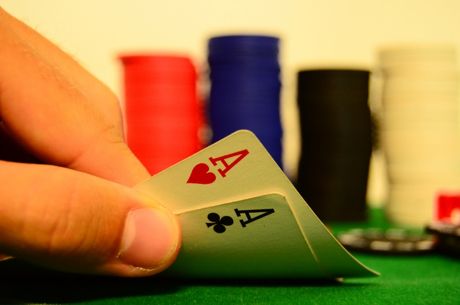Exploring the Uncapped Buy-in Structure at the Beau Rivage

A few years ago in a $2/$5 no-limit hold 'em game at the Beau Rivage poker room, a high-stakes regular bought in for $2,500. Suddenly an ego war broke out.
"Your stack's a bit light," someone smirked. The high-stakes regular shrugged, reached into his jacket, and tossed a hefty brick of cash onto the felt. Then he glanced at shift manager Adam Nash for approval. Nash nodded and said, "Cash will be in play after this hand."
Welcome to one of the only poker rooms in the country with an uncapped buy-in across all games.
Cash no longer plays at the popular Biloxi casino (or at any MGM property, as of April 2015). But according to Nash, who spoke with me recently during the Million Dollar Heater tournament series, the uncapped buy-in structure isn't going anywhere.
"The majority of people love it," he said.
The Beau's $1/$3 and $2/$5 no-limit games, which can play up to 500 or 1,000 big blinds deep, generate plenty of action and excitement.
"There are times when I'm here on a random Tuesday and I'm sitting in a pretty boring $1/$3 game," said Norris*, a Beau regular since 2008. "Then a guy who came from the pits will sit down with $7,000 and say, 'Let's gamble.'"
Stack Depth and Skill Edge
For Norris and other skilled professionals, uncapped games present opportunities not only "to gamble" but also to realize a deep-stacked advantage. Playing deep requires you to make more decisions in a hand. Making good decisions �� or at least better decisions than your opponents �� yields a higher win rate.
But how much higher?
"I think my win rate against an average recreational player is 150 percent as big at 1,000 big blinds as it is at 100 big blinds," said Nate Meyvis, co-host of the Thinking Poker Podcast and strategy contributor here at PokerNews.
"Against certain kinds of players that could go way up (to 250 percent?)," Meyvis added. "Really good deep-stacked players might start with a 225 percent edge or so versus recreational players."
The relationship between skill edge and stack depth is complex. It depends on playing style, position, hand selection, table dynamics, and other factors that invite speculation.
So let's speculate.
Imagine you're in an uncapped $1/$3 game with 100 big blinds when a tourist buys in for $7,000 and says, "Let's gamble." You happen to have $7,000 in your pocket, which means that you can choose to sit 2,333 big blinds deep against a gambly recreational player. Should you add more chips? If so, how many?
Here are a few things to consider:
Skill Edge
- What's your edge against the table?
- What's your edge against specific players at the table?
Stack Depth
- What range of buy-in options are available?
- How will your skill edge change depending on your stack size?
Managing Variance
- How much are you willing to lose?
- How many times are you willing to reload?
Managing Emotion
- How will you respond if you win or lose a huge pot?
- How will your tablemates respond if they win or lose a huge pot?
You might decide, in the scenario above, to add $7,000. You might decide, given bankroll considerations, just to add $1,000 and reload if you get stacked. Or you might decide to stick with 100 big blinds. Whatever you choose, avoid simply buying in for a "standard" amount and consider an effective buy-in strategy.
It's also worth remembering that (1) you can "go north" and add chips later, but you can't "go south" and remove chips from play; and (2) regardless of how much money is on the table, you can only lose the chips in front of you.
Recreational Players and the Poker Economy
With deep stacks, good action, and a well run room, the Beau Rivage may seem like poker paradise. But one downside of an uncapped buy-in structure is that, in the long run, it can hurt the local poker economy.
"If you have a recreational guy who's got a ton of money but is losing $3,000 a day, that's not sustainable," Norris explained. "He'll get discouraged, move down in stakes, or just stop playing."
Many recreational players lack the knowledge or discipline to consider buy-in strategies. They just want to gamble. Table caps protect these players from losing too much, too fast.

Better players, online training sites, and the local economy will also affect a poker room's health. But table caps, perhaps more than anything else, control the flow of money. The same gambler who quits poker after one horrific session might, under the protection of table caps, lose five or ten times that amount in the long run.
However, when you visit the Beau Rivage on a Friday night, these "big" questions about table caps and skill edges and poker economies tend to vanish.
Everything is bustle and commotion: a dealer calling out a vacant seat, the hoot of a bad beat, countless clacking chips. Tourists waddle to their tables, their pants sagging like overladen donkeys, and feed games that run all day and night, the late evenings blurring into early mornings when fresh players, sipping coffee and scanning newspapers, join stubborn bleary-eyed gamblers. Dressed smartly in suits and glasses, poker room managers Henry Garrison and Adam Nash oversee the action.
"People will ask me how much they can buy in for," Nash said, and he smiled. "I just tell them that, in these games, you are your only limit."
*Not his real name.
Ben Saxton is a teacher and a writer from upstate New York who has played small stakes poker, both live and online, since the early 2000s. Ben lives in New Orleans and covers poker on the Gulf Coast.









